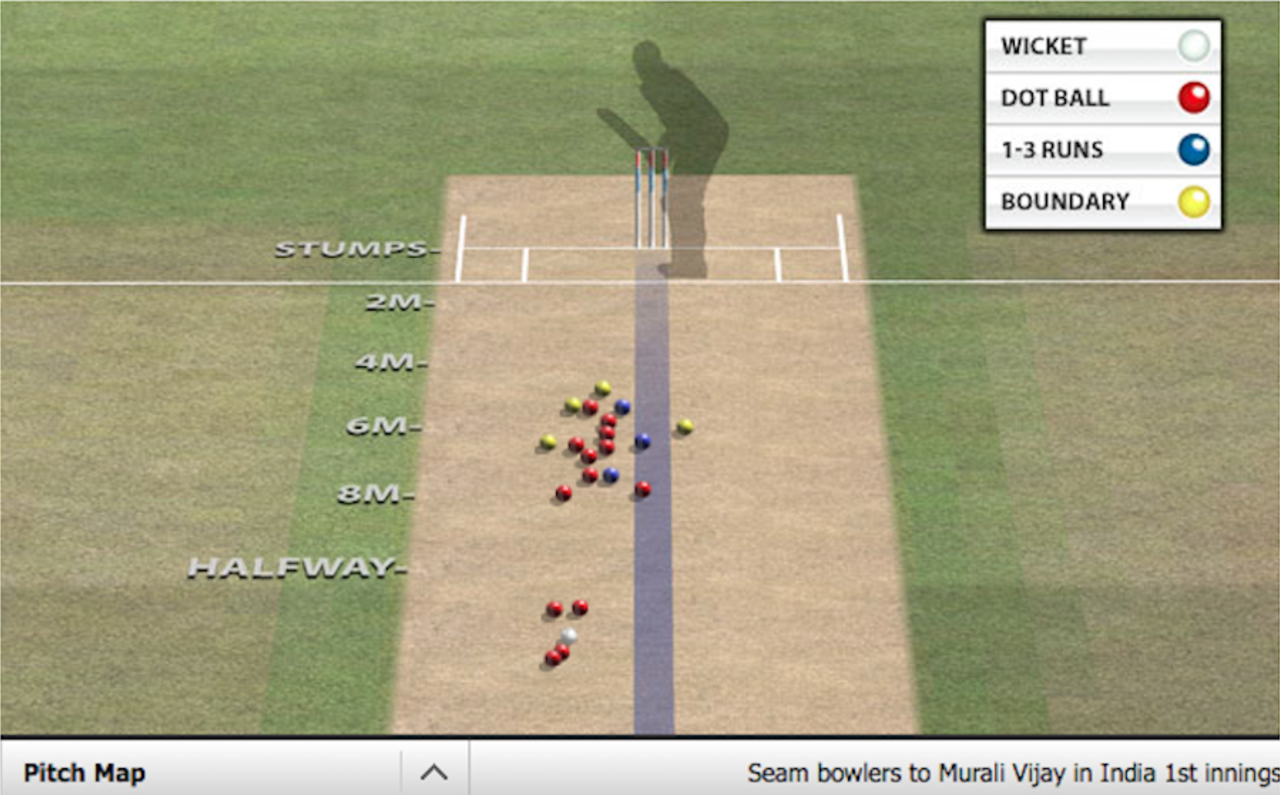Pujara's changes to succeed against short balls
From Cheteshwar Pujara's tactics against the short balls, to the England seamers' line against M Vijay, Aakash Chopra examines the technical talking points from the first day in Visakhapatnam
Aakash Chopra
17-Nov-2016

Pitch map of seam bowlers to M Vijay on the first day • ESPNcricinfo Ltd
England bowled straighter to Vijay
M Vijay had gotten out a couple of times edging to fast bowlers in the Test series against New Zealand. Last month, his trigger movement was a slight forward press and that, perhaps, led him to play inside the line. In Rajkot, Vijay started moving back and across in the trigger movement, for that meant his head getting on top of off stump and that helped him leave balls outside off. In Visakhapatnam, the England bowlers, especially James Anderson bowled a lot straighter. This shows the constant evolution of tactics in international cricket.
Pujara against the short balls
Change in tactics. Ben Stokes and Alastair Cook have abandoned the outside-off line for Cheteshwar Pujara and decided to give the bouncer-trap a go. There's a short leg, a leg gully and two fielders in the deep, square on the leg side. Pujara has handled the threat quite well in Visakhapatnam as compared to his struggles against the bouncers in Rajkot. In the previous Test, he was planting his front foot in a long and across stride, which led to the upper body getting blocked. Here, he has kept a very short forward stride and also marginally straighter, which has allowed him to handle the short balls better.
Kohli and the outside-off-stump line
If anyone has an elephant's memory in international cricket, it has to be the bowlers' clan. Two years ago, Virat Kohli had his share of problems against the outside-off line in England and that has prompted the same line of attack in Visakhapatnam too. In the first session, there was not a single ball the England fast bowlers bowled within the stumps. England either tried bouncers or kept the ball fairly outside off throughout. Such tactics don't test a batsman's technique, they test another important facet of batting in Tests - patience. Kohli has been up to the challenge thus far.

Beehive of seam bowlers to Virat Kohli•ESPNcricinfo Ltd
The first shooter on the first day
Kohli went back to a ball, from Moeen Ali in the 50th over, that was reasonably short but the ball kept really low. Kohli did well to get bat on ball and therefore no damage was done as the ball took the toe of the bat and went to the fine-leg boundary for four. But that was the first sign of uneven bounce on this surface. It will be interesting to observe if and when the balls start bouncing alarmingly too.
Right hand dominating
The coaching manual says that batting is all about the top hand. It's the top hand that dominates and the bottom hand that guides, especially for shots off the front foot through the off side. Both Pujara and Kohli have used the bottom hand to good effect, even to the front-foot shots through the covers and mid-off. Why and how? Well, the slower nature of the pitches in the subcontinent dictates that batsmen are forced to generate their own pace, and to do that it's imperative to use the bottom hand more often. The flip side of allowing the bottom hand to dominate is that the ball goes in the air from time to time and to counter it, both these batsmen have stayed low and transferred the weight at the right time.
The real Indian pitch
This is a proper Indian pitch with smaller blocks running through the 22 yards. There's only a sprinkling of dry-cut grass, which is unlikely to keep the track together. On such pitches, the cracks don't open up but crumble as the match progresses. Also, the footmarks are likely to make their appearance felt early in the game.
Aakash Chopra is the author of three books, the latest of which is The Insider: Decoding the craft of cricket. @cricketaakash